© 2020 IBM Page 1 of 44
DEPLOYING IBM® INFOSPHERE DATA
REPLICATION® WITH A
MICROSOFT® SQL SERVER® DATABASE
PARTICIPATING IN AN ALWAYSON
AVAILABILITY GROUP
© 2020 IBM Page 2 of 44
Table of Contents
1 Deploying IIDR in Microsoft SQL Server AlwaysOn availability group .................................................. 3
2 Overview ............................................................................................................................................... 3
3 Prepare the AlwaysOn availability group environment for replication ................................................ 5
3.1 Configure the Remote Distributor. .............................................................................................. 5
3.2 Configure the remote distributors on the possible publishers .................................................. 13
3.3 Configure all replicas as Replication publishers ......................................................................... 18
3.4 Redirect the original publisher to the AlwaysOn Listener Name............................................... 21
3.5 Run the Replication Validation Stored Procedure to Verify the Configuration ......................... 22
4 Add symmetrical shared clustered disk reachable from all AlwaysOn nodes .................................... 22
5 Define a Microsoft Windows domain user that can be used to run the IIDR service ........................ 26
5.1 Transaction log backups shared storage .................................................................................... 26
6 Microsoft SQL Server transaction log maintenance plans .................................................................. 27
7 IIDR Database authentication user ..................................................................................................... 30
8 Deploy IIDR on the shared clustered disk ........................................................................................... 31
9 Create IIDR service on secondary synchronous replicas .................................................................... 35
10 Configure the new Datastore in Management Console ................................................................. 40
11 Test the deployment....................................................................................................................... 41
12 Persistent subscriptions .................................................................................................................. 41
12.1 Considerations around automatic subscription restart for persistent subscriptions ................ 41
13 Considerations when transitioning the database to an AlwaysOn availability group ................... 42
14 Considerations when transitioning the database out of an AlwaysOn availability group ............. 42
14.1 Using an existing IIDR installation on Clustered Disk ................................................................. 43
14.2 Using a new IIDR installation on Local Disk ................................................................................ 43
15 Resuming replication after automatic or manual failover to a synchronous replica ..................... 44
16 Resuming replication after forced failover to an asynchronous replica ........................................ 44

© 2020 IBM Page 3 of 44
1 Deploying IIDR in Microsoft SQL Server AlwaysOn
availability group
The following document describes the steps required to be taken in order to deploy IIDR with a
database that is participating in a Microsoft SQL Server Availability Group. These steps are required
when the IIDR will serve as a source for data replication.
2 Overview
Before proceeding, ensure that all prerequisites for installing IIDR are met. For more information see:
https://www.ibm.com/support/knowledgecenter/en/SSTRGZ_11.4.0/com.ibm.cdcdoc.cdcformssql.doc/
concepts/before_install.html
In order to be able to deploy IIDR in a Microsoft SQL Server AlwaysOn environment one needs to:
- Prepare the AlwaysOn availability group environment for replication
- Add symmetrical shared storage for IIDR deployment reachable from all AlwaysOn nodes
- Define a Microsoft Windows domain user that can be used to run the IIDR service
- Identify shared storage to which the transaction logs can be backed up. The storage must be
symmetrically accessible from all AlwaysOn nodes
- Define maintenance plans to back up the transaction logs to the backup storage on any number
of nodes
- Create the IIDR user that can connect to the database on all nodes where it may fail over
- Deploy IIDR on the shared symmetrical storage
- Create the IIDR service on all nodes to which IIDR may fail during planned or unplanned failover.
Any number of nodes that are configured for Synchronous Commit availability mode could be
used
- Add the IIDR service as a dependent resource to the AlwaysOn availability group role that was
created in the Windows Server Failover Cluster
- Configure the new Datastore in IBM Management Console

© 2020 IBM Page 4 of 44

© 2020 IBM Page 5 of 44
3 Prepare the AlwaysOn availability group environment for
replication
The following information is provided for guidance only. Please consult Microsoft documentation for
exact details on the steps that need to be performed in order to enable and maintain replication for a
database participating in an AlwaysOn availability group.
Adapted from:
http://blogs.msdn.com/b/alwaysonpro/archive/2014/01/30/setting-up-replication-on-a-database-that-
is-part-of-an-alwayson-availability-group.aspx
More information at:
https://msdn.microsoft.com/en-CA/library/hh710046.aspx
Review Microsoft documentation on AlwaysOn or Windows Server Failover Cluster terms and
definitions:
https://msdn.microsoft.com/en-CA/library/hh270278.aspx
The first step in preparing the environment for replication is to configure a standalone server that will
serve as a remote distributor for the AlwaysOn availability group replica. In our example, connect to
cdcdev20 and start configuring it to be able to serve as a remote distributor.
3.1 Configure the Remote Distributor.
Right Click Replication and select Enable Distribution.

© 2020 IBM Page 6 of 44

© 2020 IBM Page 7 of 44
We’ll select the first option as we want cdcdev20 as a distributor
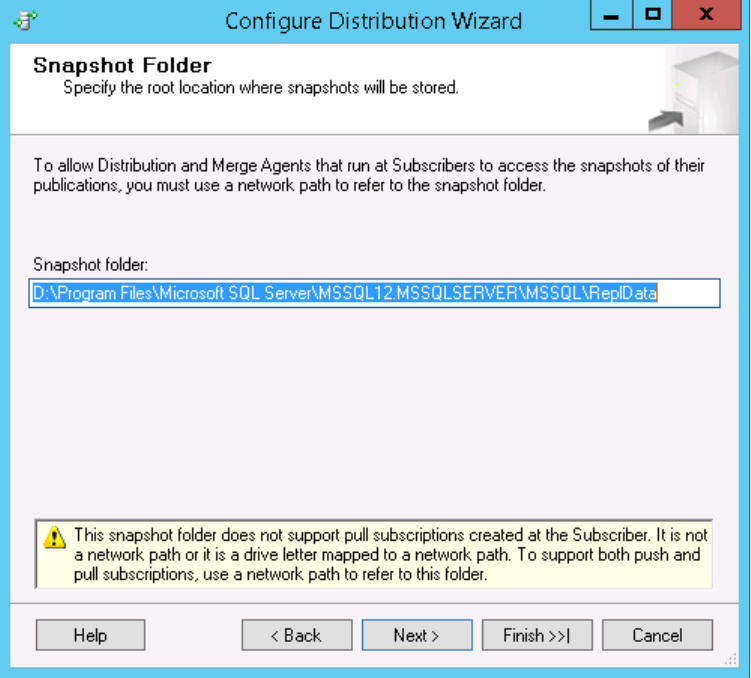
© 2020 IBM Page 8 of 44
Follow with the default snapshot folder:

© 2020 IBM Page 9 of 44
Use the defaults for distribution database:

© 2020 IBM Page 10 of 44
In the screen below we need to add the cdcdev17, cdcdev18 and cdcdev19 as possible publishers.
Authenticate to all servers while adding the publishers.

© 2020 IBM Page 11 of 44
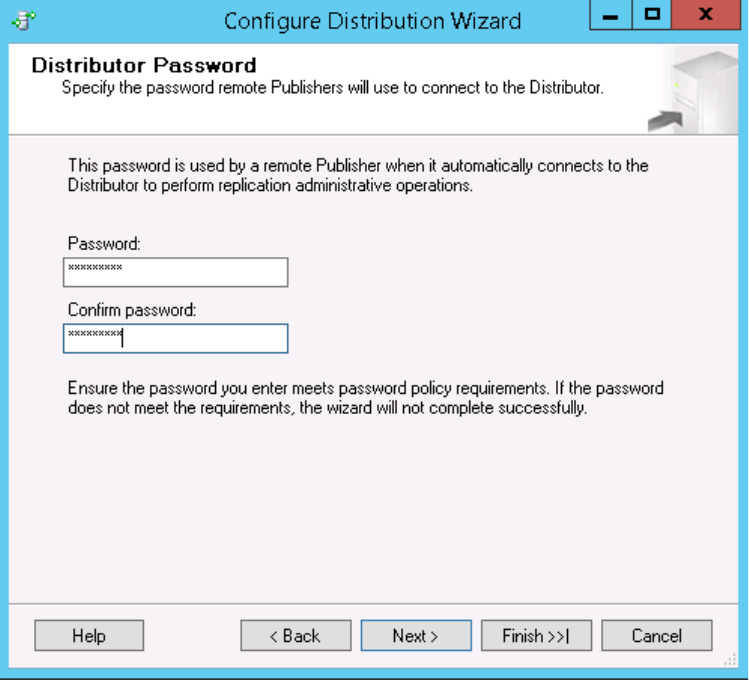
© 2020 IBM Page 12 of 44
Enter the password that the publishers will use when connecting to the remote distributor.
This information will be needed when configuring the publishers.
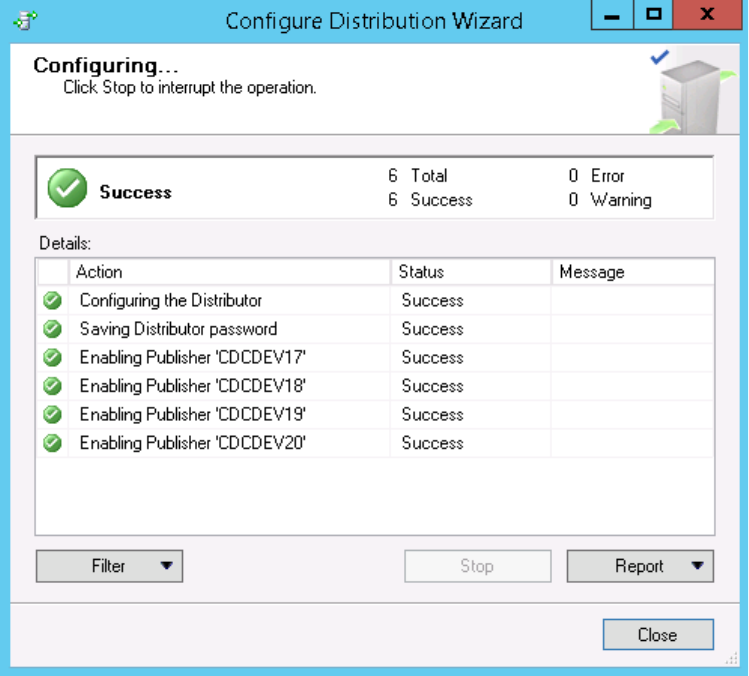
© 2020 IBM Page 13 of 44
Click Next, make sure that “Configure Distribution” is checked then Next, then Finish.
3.2 Configure the remote distributors on the possible publishers
For the possible publishers, we need to configure distribution as a remote distribution that we created
on cdcdev20. Right click Replication and choose Configure Distribution…

© 2020 IBM Page 14 of 44

© 2020 IBM Page 15 of 44
Use cdcdev20 as a distributor for this Microsoft SQL Server instance.

© 2020 IBM Page 16 of 44
In the Administrative Password dialog, type in the same password that was used when configuring the
remote distributor in the previous configuration step.
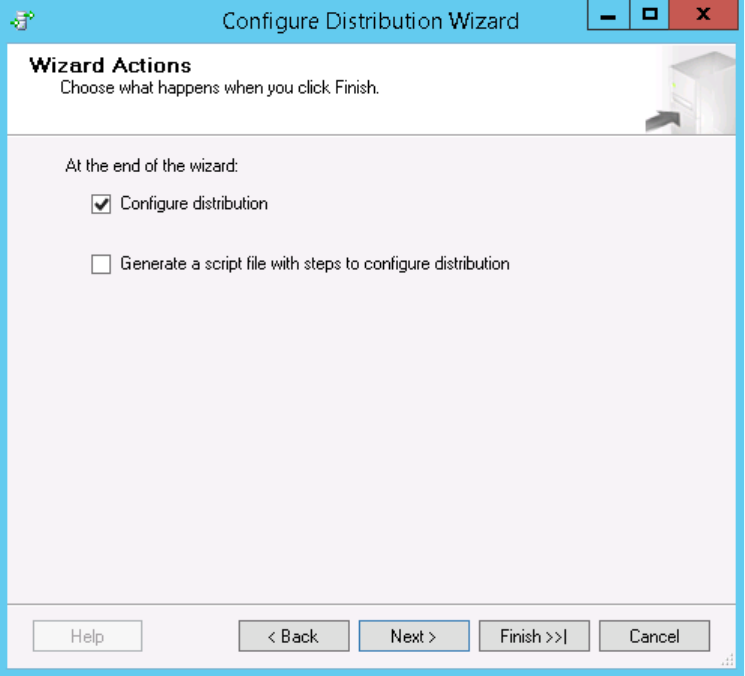
© 2020 IBM Page 17 of 44
In the Wizard Action dialog accept the defaults and click Finish.

© 2020 IBM Page 18 of 44
Repeat the steps to configure the remote distributor on the rest of the nodes that could become
publishers: CDCDEV18 because it is a SYNCHRONOUS replica. CDCDEV19 does not need this because it is
configured as an ASYNCHRONOUS replica.
3.3 Configure all replicas as Replication publishers
For each of the possible publishers (CDCDEV17, CDCDEV18 synchronous replicas only), create a linked
server with the name of the remote distributor.
- Right click Server Objects -> Linked Servers and select Add Linked Server
- Type in the linked server name: CDCDEV20.
- Choose the SQL Server type
- Configure security for the linked server
- On the server options enable RPC Out
- Click Ok

© 2020 IBM Page 19 of 44

© 2020 IBM Page 20 of 44
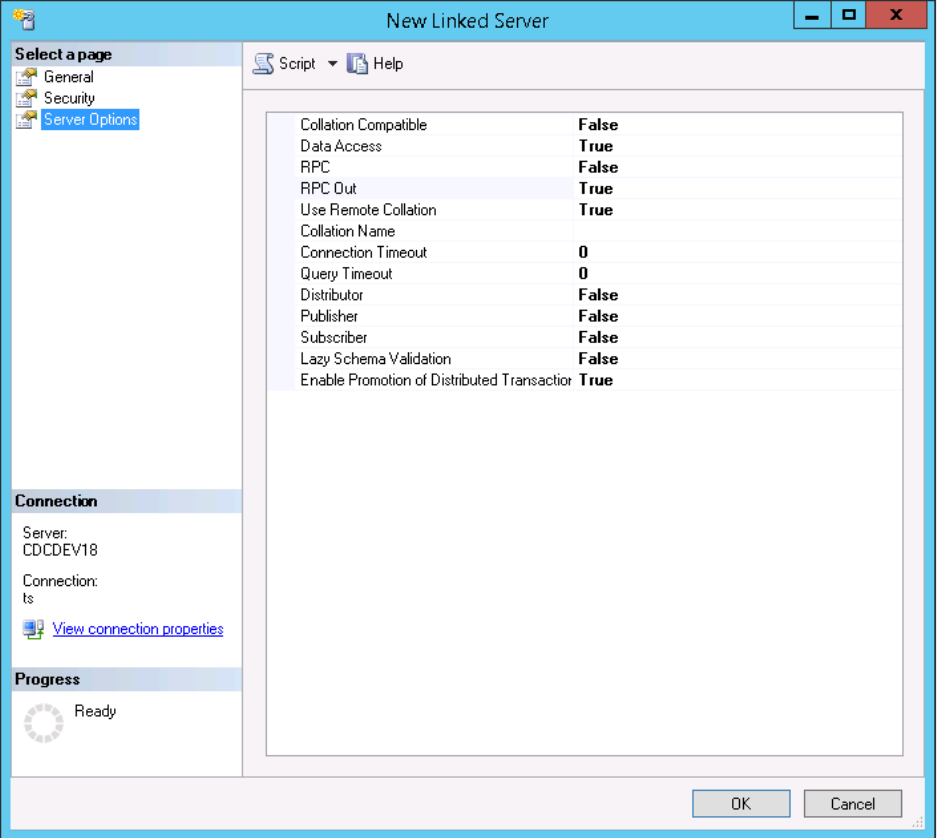
© 2020 IBM Page 21 of 44
Alternatively, use stored procedures to configure the linked server. For additional information,
please refer to Microsoft documentation on configuring Linked servers.
3.4 Redirect the original publisher to the AlwaysOn Listener Name
At the distributor, in the distribution database, run the stored procedure sp_redirect_publisher to
associate the original publisher and the published database with the availability group listener name of
the availability group.
USE distribution;
GO
EXEC sys.sp_redirect_publisher
@original_publisher = 'CDCDEV17',
@publisher_db = 'TestDb',
@redirected_publisher = 'cdcsql2014lsn1,5025';

© 2020 IBM Page 22 of 44
Review Microsoft documentation on maintenance steps for the redirected publisher. Some of possible
documents to review are:
https://msdn.microsoft.com/en-us/library/hh710048.aspx
https://msdn.microsoft.com/en-us/library/hh403414.aspx
3.5 Run the Replication Validation Stored Procedure to Verify the
Configuration
At the distributor, in the distribution database, run the stored procedure
sp_validate_replica_hosts_as_publishers to verify that all replica hosts are now configured to serve as
publishers for the published database.
USE distribution;
DECLARE @redirected_publisher sysname;
EXEC sys.sp_validate_replica_hosts_as_publishers
@original_publisher = 'CDCDEV17',
@publisher_db = 'TestDb',
@redirected_publisher = @redirected_publisher output;
select @redirected_publisher
Review Microsoft documentation on maintaining the redirected original publisher. Review Microsoft
documentation on maintenance steps for the redirected publisher. Some of possible documents to
review are:
https://msdn.microsoft.com/en-us/library/hh710048.aspx
https://msdn.microsoft.com/en-us/library/hh403414.aspx
4 Add symmetrical shared clustered disk reachable from all
AlwaysOn nodes
In order to continue with the replication preparation, shared clustered disk that will hold the IIDR
binaries and metadata has to be defined as a dependent resource in the AlwaysOn Role that was
created in the Windows Failover Cluster for the AlwaysOn deployment. These steps are similar to the
steps that are required to be performed when adding shared clustered disk for the Microsoft SQL Server
Clustering solution: https://msdn.microsoft.com/en-us/library/ms179530.aspx. More details on how to
add Shared clustered disk can be found at:
http://blogs.msdn.com/b/clustering/archive/2012/06/02/10314262.aspx

© 2020 IBM Page 23 of 44
Add your clustered disk to the Storage -> Disks.
Open the Failover Cluster Manager and find the Role that was defined by the AlwaysOn
configuration.

© 2020 IBM Page 24 of 44
Right click the AlwaysOn role and select add storage.

© 2020 IBM Page 25 of 44
Select the disk and click OK.

© 2020 IBM Page 26 of 44
5 Define a Microsoft Windows domain user that can be used
to run the IIDR service
Given the distributed nature of the AlwaysOn deployment and the fact that IIDR will need to read logs
from network share, you need to have a Windows domain user that has network resource access.
5.1 Transaction log backups shared storage
Identify shared storage to which the transaction logs can be backed up. The storage has to be
symmetrically accessible from all AlwaysOn nodes.
The backup strategy is expanded in AlwaysOn deployments. One can choose to perform different types
of backups on any number of nodes. The metadata about the backups is found in the msdb database
that is present on the SQL Server instance deployed on the node that was responsible for taking the
backup. The information about the transaction log backups is important to IIDR as it permits identifying
which transaction log backups contain the data that needs to be processed next. Accessing the physical
transaction log files is just as important for IIDR. Immediately after CDC identifies which files contain the
data that needs to be processed next, CDC will try to access and read data from those transaction log
backups. All backups taken from any Microsoft SQL Server instance need to be taken to a similar shared
location. More information can be found at:

© 2020 IBM Page 27 of 44
http://blogs.msdn.com/b/sqlgardner/archive/2012/07/18/sql-2012-alwayson-and-backups-part-1-
offloading-the-work-to-a-replica.aspx
http://blogs.msdn.com/b/sqlgardner/archive/2012/07/21/sql-2012-alwayson-and-backups-part-2-
configuring-backup-preferences-and-automating-backups.aspx
http://blogs.msdn.com/b/sqlgardner/archive/2012/08/28/sql-2012-alwayson-and-backups-part-3-
restore.aspx
If the transaction log backup is already found in a shared network directory, make sure that it is
readable by the IIDR process user.
If the backup directory is not a network drive, then:
- Define a network directory (UNC path, or mapped drive), that is symmetrically accessible from
all nodes
- Microsoft SQL Server service user has all the privileges that are needed by Microsoft SQL Server
to create successful backups to this shared network directory. Pease see Microsoft
documentation for details
- Ensure that IIDR service user has read access to this network directory
For the purpose of our test, we defined \\CDCDEV20\Backups with all the required access privileges.
6 Microsoft SQL Server transaction log maintenance plans
As mentioned in section 5.1, AlwaysOn expands on the Microsoft backup. The backups, including
transaction log backups, can be offloaded to any replica. Given that the metadata for the backups is
found in the msdb database and it cannot be part of an availability group, the metadata about the
transaction log backups will only be found on the Microsoft SQL Server instance that created the
backup. The next section will describe how to set up transaction log backup using a Microsoft
maintenance plan.
- Right click on CDCDEV17 Management-> Maintenance plans and select “Maintenance Plan
Wizard”. Click Next
- Provide an identifiable name for the plan. For ease of maintenance, you may want to keep the
plan names consistent and unique across all the Microsoft SQL Server instance where they may
be defined
- Define a schedule for the maintenance plan
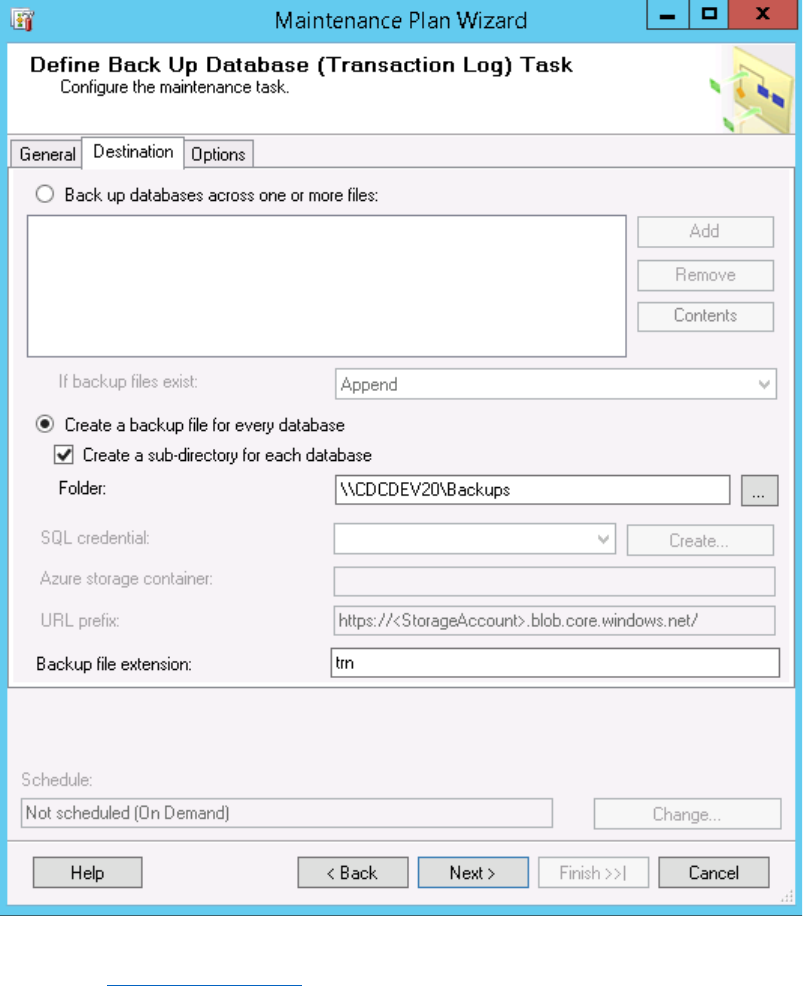
© 2020 IBM Page 29 of 44
- Click Next. Choose a shared folder where you want the report to be written. You could choose
the \\CDCDEV20\Backups as the location assuming you checked the “Create a sub-directory for
each database” on the previous screen. IIDR will issue a warning if the directory that is supposed
to contain transaction log backups contains files of other types when it discovers metadata
about transaction logs based on the files found in that directory
- Click Next. Click Finish

© 2020 IBM Page 30 of 44
- Repeat the Maintenance plan creation on any of nodes that you want to participate in
maintaining the chain of transaction log backups
For more information on maintenance plans or AlwaysOn backup strategies, please see Microsoft SQL
Server documentation.
7 IIDR Database authentication user
Create an IIDR user able to connect to the database on all nodes where it may fail over.
In order to have IIDR fail over smoothly from a primary node to a new primary node, it will need to be
able to connect to the database with the same user name and password and privileges on any
availability replica to which it could fail over and any node where a transaction log backup could be
taken. Now you can define the user with which IIDR will connect to a Microsoft SQL Server instance. This
user can be used for data replication, table metadata discovery, or for connecting to the msdb database
in order to extract metadata about transaction log backups.
- On each Microsoft SQL Server instance, right click Security and select New Login… Choose the
user name/password, and role for the IIDR user. For more information, see:

© 2020 IBM Page 31 of 44
http://www-
01.ibm.com/support/knowledgecenter/SSTRGZ_11.3.3/com.ibm.cdcdoc.cdcformssql.doc/concepts/crea
tingawindowsaccountinsqlserver.dita?lang=en
8 Deploy IIDR on the shared clustered disk
Now that we have:
- Prepared the AlwaysOn environment for replication
- Added symmetrical shared storage for IIDR metadata
- Have a windows domain user to run IIDR service under
- Identified shared storage to which the transaction logs can be backed up
- Defined maintenance plans to back up the transaction logs to the backup storage
- Created the IIDR user to connect to Microsoft SQL Server instances
We can proceed with deploying IIDR product on the AlwaysOn availability group that holds the
current PRIMARY replica for the database. The node that holds the current PRIMARY replica should
also be the owner of the shared symmetrical storage where IIIDR needs to be deployed. In our
example, CDCDEV17 is the current primary replica and the owner of the primary replica. The
deployment is similar to any deploying IIDR for Microsoft SQL Server cluster. The difference in
deployment is that Microsoft SQL Server does not use the shared storage in this case to store the
database and the logs. For more details see:
http://www-
01.ibm.com/support/knowledgecenter/SSTRGZ_11.3.3/com.ibm.cdcdoc.cdcformssql.doc/concepts/
configuringclustered.dita?lang=en
To deploy IIDR for Microsoft SQL Server:
- Choose the installation directory and the instance directory to be on the symmetrical shared
storage.
- After deploying the product, one can create an instance. Launch the Configuration tool to create
the IIDR instance that would replicate data from the database that is part of an AlwaysOn
availability group.

© 2020 IBM Page 32 of 44
The data that needs to be filled out in the configuration tool is not much different from creating an
instance in non AlwaysOn environment. A few things to pay attention to:
- For Log on As, choose This account and type in a Windows user account that has access to
network resources.
- For host type the AlwaysOn availability group listener name that your database belongs to.
- For Port type the port number for the AlwaysOn availability group.
© 2020 IBM Page 33 of 44
- Refresh Loader path needs to be a valid path on any node IIDR may fail over to. One option to
ensure that is to use the same Shared symmetrical disk used for IIDR installation as the
refresh_loader_path.
The transaction log backups can be taken by any Microsoft SQL Server instance in the AlwaysOn
availability group cluster. As such the metadata about the files may be present in the msdb database on
different Microsoft SQL Server instances. In order to determine which transaction log backup files need
to be processed, IIDR queries the msdb database on all the nodes from the list until it finds information
about the transaction log backup that needs to be replicated.
However, in case of a failure, the Microsoft SQL Server instance where the backup was taken may be
down and as such the msdb database will be unreachable. In order to work around this possible
scenario, the directory where the transaction log backups are taken also needs to be provided.
Navigate to the AlwaysOn tab:

© 2020 IBM Page 34 of 44
- Provide a list of Microsoft SQL Server instances that could serve as transaction log backup
candidates
o IIDR will use the user name and the password from the instance configuration to
connect to the transaction log backup candidates at the provided hosts and ports to
extract metadata about transaction log backups
- Provide a folder where all the transaction log backups are taken. IIDR will use this location to
extract the transaction log backup metadata when the transaction log backup candidate

© 2020 IBM Page 35 of 44
where the transaction log backup was taken is not reachable. A few things to pay attention
to:
o The folder has to be symmetrically reachable from all nodes where IIDR could fail
over
o The folder has to exist
o The folder has to be readable by the IIDR process user
o The folder needs to contain only transaction log backup files
o Do not mix transaction log backups from multiple databases in the same folder
o The folder should not contain subdirectories. The subdirectories will not be
processed
o A large number of files in this directory can slow down IIDR responsiveness. A
warning will be issued when over 1000 files are found in the directory
9 Create IIDR service on secondary synchronous replicas
Do not start the instance after it is created. Similar services that were created on the current node that
is responsible for the active PRIMARY replica need to be created on each SECONDARY replica node
where IIDR may fail over. Navigate to IIDR installation directory and find the command
dmcreateclusterservice.exe and invoke the command for each replica to which IIDR may fail over.
dmcreateclusterservice.exe -I <IIDR instance_name> <secondary_replica_node>
For the test example that we have, we will invoke the command below. IIDR can only fail over to
SYNCHRONOUS availability mode replicas and the availability group Test is configured to have only
CDCDEV18 as a synchronous availability mode replica.
dmcreateclusterservice.exe –I SQL2014_TestDb CDCDEV18
This command will create a service “IBM InfoSphere Data Replication [SQL2014_TestDb]” on the
cdcdev18 replica.
Note: After a fail over the CDC service may fail to start. When you start the service manually, it may
inform you that there was a logon error. If you edit the user name or the password and save in the
Properties -> Log On tab, you may get a confirmation that Log On as a service privilege was granted to
the user.
You can also add the privileges manually:
https://technet.microsoft.com/en-us/library/cc794944(v=ws.10).aspx
- While being on the PRIMARY node (CDCDEV17), add the IIDR service as a dependent resource to
the AlwaysOn availability group role that was created in the Windows Failover Clustering
The next step includes adding the IIDR service as a dependent resource to the AlwaysOn
availability group role that was created in Windows Failover Cluster at the time when the
availability group was defined
- Open Windows Failover Cluster manager and navigate to the role created by the availability
group

© 2020 IBM Page 36 of 44

© 2020 IBM Page 37 of 44
- Right click the Test role and select Add Resource -> Generic Service. Select the service “IBM
InfoSphere Data Replication [SQL2014_TestDb]” and click Next
Click Next in Confirmation dialog. Click Finish in the Summary dialog.

© 2020 IBM Page 38 of 44

© 2020 IBM Page 39 of 44
Right click the new resource added to the availability group role and select Properties. Navigate to the
Dependencies tab and add the rest of the resources to the list of dependencies. This will prevent the
IIDR resource from being started prior to having the rest of the resources initialized and started after a
failover.

© 2020 IBM Page 40 of 44
Navigate to the Policies tab and choose the policy that you would want to be applied when the service
fails or is manually stopped. In most cases, users may not want to fail over the entire availability group in
case IIDR fails or is manually stopped. If this is the case, select “If Resource Fails, do no restart”. For
more information about resource properties, consult Microsoft documentation. Click OK.
Right click the service and select “Bring Online”
10 Configure the new Datastore in Management Console
When creating a new Datastore in Management Console use the AlwaysOn availability group listener
name as the host name for the new Datastore. In our example, use cdcsql2014lsn1 as the host name for
the new Datastore. The rest of the configuration is similar to defining a new Datastore. For more
information, please refer to IIDR documentation on configuring a new Datastore.
© 2020 IBM Page 41 of 44
11 Test the deployment
In order to test the deployment one would need to:
- Create a test source table in the database
- Create a test subscription in Management Console and create a table mapping between the
newly created source test table and a target table
- Insert a couple of rows in the source test table
- Start mirroring
- Check that the table has been successfully refreshed and is mirroring
- Insert a few more rows. Test that replication has been successful
- Start Windows Failover Cluster Manager and navigate to the AlwaysOn availability group role
- Right click on the role and select Move -> Select Node. Select the Synchronous replica node
(CDCDEV18)
- All resources will fail over and IIDR will be started
- The subscriptions will not be automatically started. The user will have to manually start the
subscriptions or use persistent subscriptions that permits restarting subscriptions after a
recoverable error
- Start the subscription. Insert a few more rows. Check that data has been replicated to the target
12 Persistent subscriptions
Persistent subscriptions permit subscription restart after a recoverable error. This IIDR feature is
used by default in AlwaysOn deployments in order to automatically restart the subscriptions after a
failover. In order to disable persistent subscriptions open IBM Management Console, connect to the
datastore, right click on the subscription, select properties, then Advanced Settings and uncheck the
“Mark Subscription as persistent” checkbox.
12.1 Considerations around automatic subscription restart for
persistent subscriptions
- Persistent subscriptions functionality is initiated by the source engine. Not all sources support
persistent subscriptions
- Persistent subscriptions attempt to restart a subscription at fixed intervals. By default, this fixed
interval is set to 5 minutes. If you wish to change the automatic restart interval you need to
change the system property mirror_auto_restart_interval_minutes, e.g.
mirror_auto_restart_interval_minutes = 3
- Persistent subscriptions only try to restart a subscription if it was stopped due to a recoverable
error
© 2020 IBM Page 42 of 44
13 Considerations when transitioning the database to an
AlwaysOn availability group
An existing IIDR deployment cannot be upgraded to support AlwaysOn. A new IIDR deployment is
needed in order to support AlwaysOn. One needs to follow the instructions in this document in order to
deploy a new IIDR installation that would support AlwaysOn.
If you currently have IIDR deployed and your database is not AlwaysOn, the following steps need to be
executed in order to add the database to an AlwaysOn availability group and to deploy IIDR that
supports such a database deployment.
- Establish a quiesce point for the database. This means that the database cannot be accessible to
either DML or DDL transactions. If a quiesce point cannot be established a refresh of all tables
will be needed
- Replicate all the data up to the quiesce point – i.e. to the head of log
- Upgrade your existing IIDR instance to the latest version that supports AlwaysOn. Start the
instance. This will upgrade the IIDR metadata to the latest product version
- Upgrade Management Console and Access Server to the latest version
- Add the database to an AlwaysOn availability group
- Deploy a new IIDR installation on the shared clustered disk and follow all the steps required for
an AlwaysOn IIDR deployment
- Start both instances
- Use Management Console to either export/import subscriptions or promote subscriptions from
the old non AlwaysOn deployment to the AlwaysOn deployment
- If a quiesce point has been established at the beginning and all data has been replicated to the
head of log prior to upgrade, you can Mark Table Capture Point for Mirroring for all tables in all
subscriptions in the AlwaysOn instance. This action will tell IIDR to start reading from the current
head of log. If a quiesce point could not be established at the beginning, then all tables have to
be refreshed
- A good rule of thumb is test and document the specific steps needed for your solution in a test
environment prior to making changes to production environment
14 Considerations when transitioning the database out of an
AlwaysOn availability group
One may decide to continue to use IIDR replication and no longer have their database as part of an
availability group. In order to achieve this one needs to deploy a new IIDR instance configured with the
non AlwaysOn database. Here are the steps that need to be executed when transitioning from a
© 2020 IBM Page 43 of 44
database that is part of an AlwaysOn availability group to the same database that is not part of an
availability group.
14.1 Using an existing IIDR installation on Clustered Disk
The following steps need to be executed when one wants to transition the database out of an
availability group and change IIDR to use an installation residing on local disk.
- Establish a quiesce point for the database. This means that the database cannot be accessible to
DML or DDL transactions. If a quiesce point cannot be established a refresh of all tables will be
needed
- Replicate all the data up to the quiesce point – i.e. to the head of log Remove the database from
the AlwaysOn availability group
- Create a new IIDR instance with the database that is not part of an availability group.
- You can decide you want to continue to use the remote distributor or define a local distributor
for Microsoft Replication. Make any necessary adjustments at this time
- Start both instances
- Use Management Console to either export/import subscriptions or promote subscriptions from
the old AlwaysOn instance to the non AlwaysOn instance
- Remove the IIDR service of the AlwaysOn instance from the availability group
- If a quiesce point has been established at the beginning and all data has been replicated to the
head of log prior to upgrade, you can Mark Table Capture Point for Mirroring for all tables in all
subscriptions in the AlwaysOn instance. This action will tell IIDR to start reading from the current
head of log. If a quiesce point could not be established at the beginning, then all tables have to
be refreshed
- A good rule of thumb is test and document the specific steps needed for your solution in a test
environment prior to making changes to production environment
14.2 Using a new IIDR installation on Local Disk
The following steps need to be executed when one wants to transition the database out of an
availability group and move the CDC installation from the clustered shared disk to local disk.
- Establish a quiesce point for the database. This means that the database cannot be accessible to
DML or DDL transactions. If a quiesce point cannot be established a refresh of all tables will be
needed
- Replicate all the data up to the quiesce point – i.e. to the head of log Upgrade your existing
AlwaysOn IIDR instance to the latest version of the product that you want to deploy on local
drive. Start the AlwaysOn instance. This will upgrade the IIDR metadata to the latest product
version
- Upgrade Management Console and Access Server to the latest version
© 2020 IBM Page 44 of 44
- Remove the database from an AlwaysOn availability group
- Deploy a new IIDR installation on the local disk
- You can decide you want to continue to use the remote distributor or define a local distributor
for Microsoft Replication. Make any necessary adjustments at this time
- Start both instances
- Use Management Console to either export/import subscriptions or promote subscriptions from
the old AlwaysOn deployment to the new non AlwaysOn deployment
- If a quiesce point has been established at the beginning and all data has been replicated to the
head of log prior to upgrade, you can Mark Table Capture Point for Mirroring for all tables in all
subscriptions in the AlwaysOn instance. This action will tell IIDR to start reading from the current
head of log. If a quiesce point could not be established at the beginning, then all tables have to
be refreshed.
- A good rule of thumb is test and document the specific steps needed for your solution in a test
environment prior to making changes to production environment.
15 Resuming replication after automatic or manual failover to
a synchronous replica
As you probably have already tested, after a failover to a new PRIMARY replica, IIDR fails together with
the availability group to the new node. Assuming the subscriptions have been marked persistent, the
replication will also automatically restart and continue from where it left over on the previous PRIMARY
replica. Subscriptions are marked as persistent by default, when IIDR is configured with a database
contained in an AlwaysOn availability group.
16 Resuming replication after forced failover to an
asynchronous replica
IIDR only supports replication from a synchronous replica. IIDR does not support failing over to an
asynchronous replica. In addition, if you failover back to the previous PRIMARY replica, IIDR will not be
able to continue mirroring, because IIDR does not support failover from an ASYNCHRONOUS replica.
In order to recover from such a situation, you will need to either define a new set of synchronous
replicas or fail over to the original PRIMARY replica, ensure that Microsoft Replication continues to be
properly configured for the environment and initiate Refresh/Mirror for all tables.

